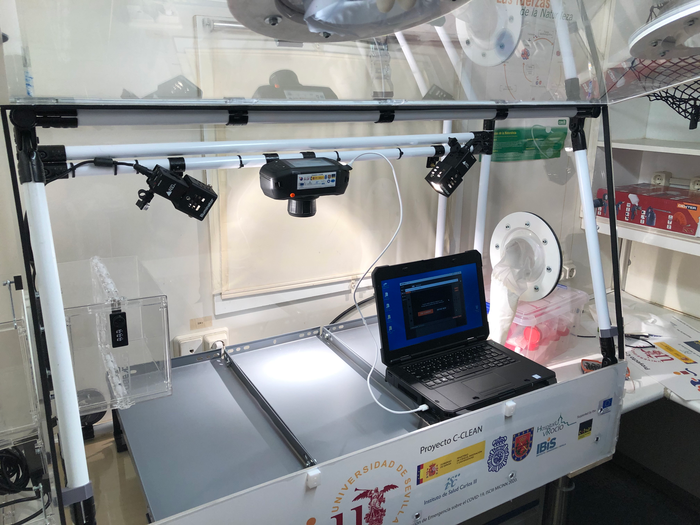The novel method enables the detection of SARS-CoV-2 in nasopharyngeal exudate (the very same samples used in a PCR test) from symptomatic individuals with a sensitivity of 100% and selectivity of 87.5%.
 Mobile security cabin for handling biological samples developed in the C-CLEAN Project, installed in the laboratory-truck of the EOD-CBRN Specialty of the Spanish National Police. Image Credit: University of Seville.
Mobile security cabin for handling biological samples developed in the C-CLEAN Project, installed in the laboratory-truck of the EOD-CBRN Specialty of the Spanish National Police. Image Credit: University of Seville.
The results of the study were published in the Nature Group’s Scientific Reports.
The newly devised method also enabled the detection of the SARS-CoV-2 in asymptomatic people’s saliva, thereby detecting, differentiating and quantifying two types of synthetic viruses (lentiviruses and synthetic coronaviruses) in two biofluids (saline solution and artificial saliva).
The major benefit of this new technology over PCR is the speed with which samples are processed and the optical system’s capacity to evaluate a large number of samples at once.
The researchers point out that these findings should be viewed with caution because they are only a “proof of concept,” based on a small number of instances and imperfectly controlled laboratory conditions. As a result, they are currently seeking to validate this novel methodology under a variety of situations, including new viral types and vaccine effects.
Through hyperspectral imaging and data processing based on advanced statistics and artificial intelligence, this innovative technology enables the identification of viruses in liquid droplets and dry residues deposited on surfaces. It enables the quick processing of several samples at the same time, without the use of chemicals or contact, and with very simple equipment that can be used by anyone with little training.
This innovative technique makes use of common optical equipment and was designed to be used in resource-constrained environments. The method has been patented, and the researchers are looking at different ways to set it up quickly and cheaply.
Prof. Emilio Gomez-Gonzalez who designed the method and its implementation was the Principal Investigator of the Project and was also the Professor of Applied Physics at the ETSI Engineering School of the University of Seville, where he directs Group of Interdisciplinary Physics (GFI).
Prof. Gonzalez is also a researcher at the Group of Applied Neuroscience of the Institute of Biomedicine of Seville (IBIS) and collaborator of the HUMAINT Project of the JRC.
With a significant Andalusian component and European backing, the C-CLEAN Project was carried out by more than 30 scientists from 11 Spanish institutions. Participant institutions were the University of Seville as a research coordinator, in addition to the EOD-CBRN Group of the Spanish National Police, and the Andalusian Network for the Design and Translation of Advanced Therapies (RAdytTA).
Other institutes included were: the Institute of Biomedicine of Seville (IBIS), the Calar Alto Astronomical Observatory (CAHA, Almería), the University Hospital “Virgen del Rocío” (Seville), the University Hospital “Virgen Macarena” (Seville), the Institute of Astrophysics of Andalucía (IAA-CSIC, Granada), the University of Cádiz-INIBICA, and the Technological Corporation of Andalusia (CTA).
These institutes collaborated with the support of the HUMAINT Project of the Joint Research Centre (JRC) of the European Commission. In addition, three companies also collaborated — Cambrico Biotech, SAMU, y el Centro Educacional Residencial Dr. Gregorio Medina Blanco.
Specifically, the Spanish National Police’s EOD-CBRN Group has played a significant role in the Project’s scientific, logistical and tactical actions.
The method’s principles and early findings of application to the detection of another synthetic model of SARS-CoV-2 were reported in the very same journal in August 2021. The C-CLEAN Project has been a huge scientific and technological challenge that has been completed in a very short period (15 months) amid the COVID-19 pandemic’s extremely harsh circumstances.
It is a complicated study whose findings have been subjected to a thorough and lengthy review (6 months).
Project COV20/00080 is funded by the Institute of Health “Carlos III,” Spanish Ministry of Science and Innovation’s Emergency Call for Research Projects on SARS-CoV-2 and COVID-19 disease.
Grant EQC2019-006240-P was funded by MCIN/AEI/ 10.13039/501100011033 and by “ERDF A way of making Europe.” Grant AEI RTI2018-094465-J was granted to one of the researchers.
Journal Reference:
Gomez-Gonzalez, E., et al. (2022) Optical imaging spectroscopy for rapid, primary screening of SARS-CoV-2: a proof of concept. Scientific Reports. doi.org/10.1038/s41598-022-06393-3.